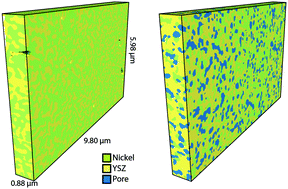Three-dimensional microstructure of high-performance pulsed-laser deposited Ni–YSZ SOFC anodes
Abstract
The Ni–yttria-stabilized zirconia (YSZ) anode functional layer in solid oxide fuel cells produced by pulsed laser-deposition was studied using three-dimensional tomography. Anode feature sizes of ∼130 nm were quite small relative to typical anodes, but errors arising in imaging and segmentation were shown using a sensitivity analysis to be acceptable. Electrochemical characterization showed that these cells achieved a relatively high maximum power density of 1.4 W cm−2 with low cell resistance at an operating temperature of 600 °C. The tomographic data showed anode three-phase boundary density of ∼56 μm−2, more than 10 times the value observed in conventional Ni–YSZ anodes. Anode polarization resistance values, predicted by combining the structural data and literature values of three-phase boundary resistance in an electrochemical model, were consistent with measured electrochemical impedance spectra, explaining the excellent intermediate-temperature performance of these cells.


 Please wait while we load your content...
Please wait while we load your content...